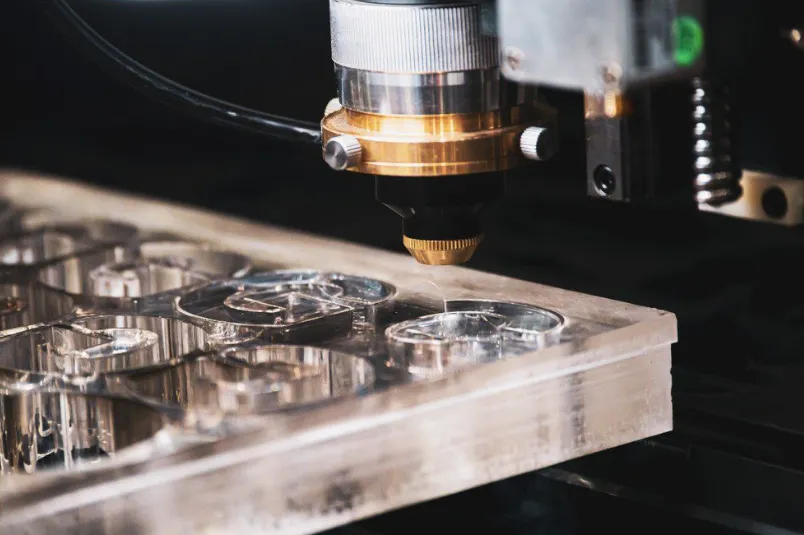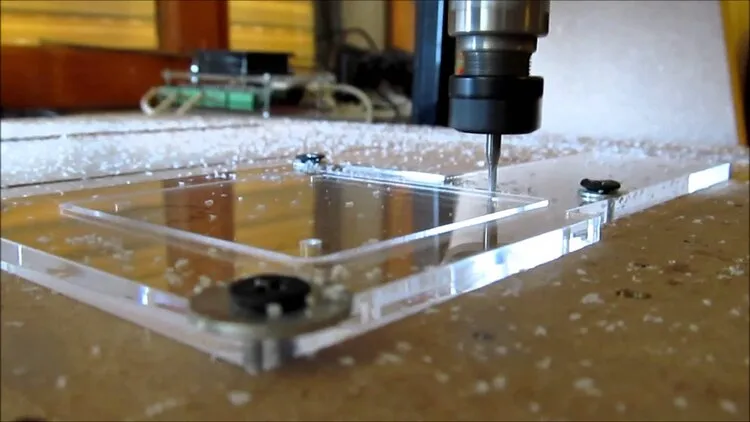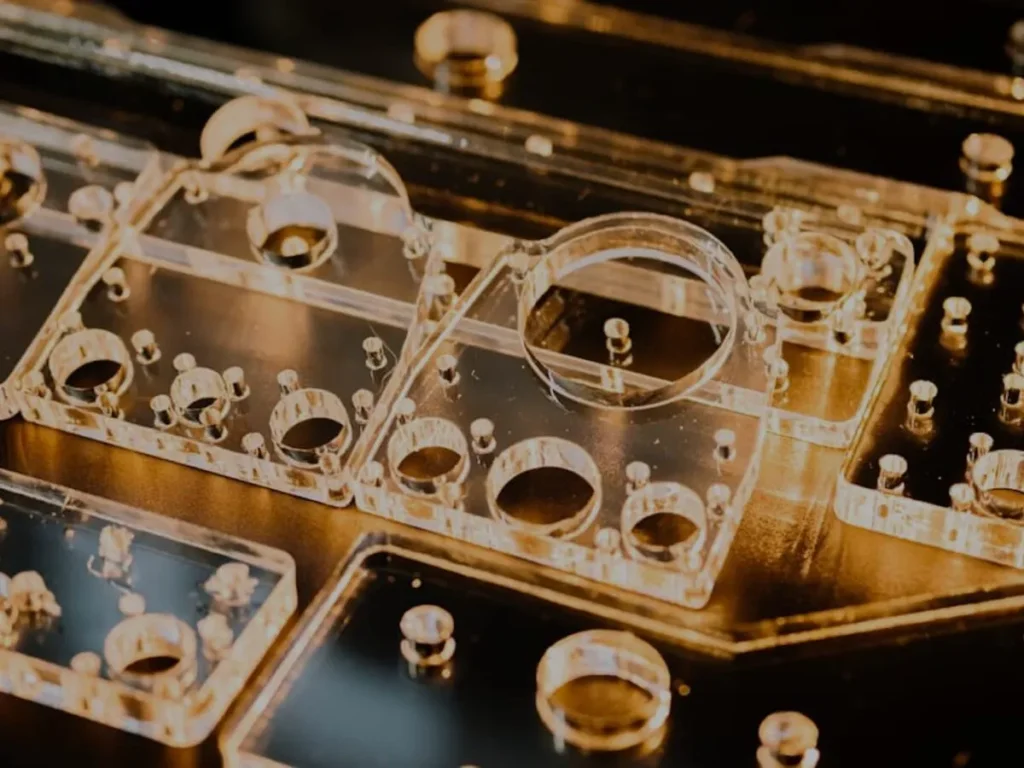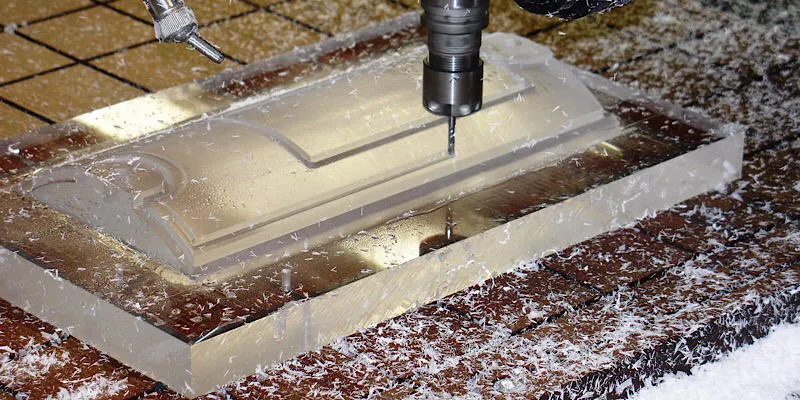Material Properties and Machining Considerations
Acrylic (PMMA) presents unique machining challenges due to its thermal sensitivity and brittle nature. The material softens at 105°C and melts around 160°C, requiring careful heat management during CNC operations. Its low thermal conductivity (0.17-0.19 W/m·K) causes heat to concentrate at cutting zones, potentially leading to melting or tool fouling. Acrylic’s coefficient of thermal expansion (7×10⁻⁵/°C) demands stable workshop temperatures for precision work, as dimensional changes become noticeable at tolerances below 0.1mm. The material’s hardness (80-90 Rockwell M) and fracture toughness (0.7-1.6 MPa·m½) require sharp cutting tools to prevent edge chipping, particularly when machining thin walls or sharp internal corners.
 CNC Machine Requirements
CNC Machine Requirements
Optimal acrylic machining requires CNC systems with specific capabilities. High-speed spindles (18,000-30,000 RPM) minimize heat buildup through rapid, light cuts, while brushless servo motors provide the acceleration needed for intricate toolpaths. Machines should offer at least 0.01mm positional accuracy and incorporate vibration-dampening features to prevent surface artifacts. Dedicated plastic-cutting vacuum tables with adjustable zone controls securely hold sheets without distortion, and integrated dust collection systems (400-600 CFM) maintain visibility and prevent recast particles from marring surfaces. For production environments, automatic tool changers with 10+ stations enable uninterrupted processing of complex parts.
Tooling Selection and Geometry
Cutting tool design significantly impacts acrylic machining quality. Solid carbide end mills with 2-4 flutes provide the best balance between material removal and heat generation. For clear acrylic, tools should feature:
- 30-45° helix angles for efficient chip evacuation
- Highly polished flutes (Ra <0.2μm) to reduce material adhesion
- Sharp cutting edges (35-55° rake angles) for clean shearing
- Relief angles of 10-15° to prevent rubbing
Compression cutters prove ideal for double-sided machining of sheet goods, while diamond-coated tools extend tool life when processing glass-filled acrylic composites. Tool diameters typically range from 1mm for fine detail work to 12mm for heavy material removal, with length-to-diameter ratios kept below 4:1 to minimize deflection.

Optimal Cutting Parameters
Precision acrylic machining requires carefully balanced operating conditions:
| Operation Type | Feed Rate (mm/min) | Spindle Speed (RPM) | Depth of Cut (mm) | Stepover (%) |
|---|---|---|---|---|
| Roughing | 1,000-2,500 | 12,000-18,000 | 1.5-3.0 | 40-60 |
| Finishing | 800-1,500 | 18,000-24,000 | 0.1-0.5 | 5-15 |
| Profiling | 600-1,200 | 15,000-20,000 | Full material | N/A |
| Engraving | 300-800 | 20,000-30,000 | 0.05-0.20 | 1-3 |
Coolant systems should use compressed air or alcohol-based mist rather than water-based fluids to prevent stress cracking. Peck drilling cycles with 0.5-1.0mm retract intervals prevent chip packing in deep holes.
Surface Finishing Techniques
Achieving optical clarity requires specialized post-machining treatments. Flame polishing with hydrogen-fueled torches (1,300-1,500°C) produces the clearest edges but demands skilled operators. Alternative methods include:
- Diamond micro-milling (Ra 0.1-0.4μm)
- Vapor polishing with dichloromethane/alcohol mixtures
- Centrifugal polishing with ceramic media
- UV-curable coating applications
For critical optical applications, diamond turning with single-point tools can achieve surface roughness below 10nm Ra. Protective masking films should remain installed during all machining operations to prevent surface scratching.

Industrial Applications and Case Studies
CNC-machined acrylic components serve vital roles across industries. Medical device manufacturers utilize machined acrylic for:
- Laboratory microfluidic devices (±0.025mm tolerance)
- MRI machine components (low magnetic interference)
- Surgical instrument housings (autoclavable grades)
The lighting industry depends on precision-machined acrylic for:
- LED light guides (92% light transmission)
- Optical diffusers (custom surface textures)
- Reflector panels (vacuum metalized surfaces)
Aerospace applications include:
- Aircraft window prototypes (impact-resistant grades)
- Cabin interior components (FST-compliant formulations)
- Instrument covers (anti-static treated)

Quality Assurance Protocols
Rigorous inspection procedures ensure acrylic parts meet specifications:
- Dimensional Verification
- Laser scanners for full 3D profile analysis
- Optical comparators for 2D feature inspection
- Contact CMMs with 1μm resolution probes
- Optical Testing
- Spectrophotometers measuring light transmission
- Haze meters quantifying surface diffusion
- Polariscope examination of internal stresses
- Mechanical Testing
- Shore D hardness testing
- Izod impact resistance evaluation
- Tensile strength verification

Emerging Technologies
Innovations in acrylic CNC machining include:
- Hybrid laser/mechanical systems for combined cutting and edge polishing
- AI-powered adaptive control systems that optimize feeds/speeds in real-time
- Nanostructured carbide tools with reduced adhesion properties
- In-process vision systems for automatic defect detection
These advancements enable tighter tolerances (±0.01mm achievable), reduced cycle times (30-50% improvements), and superior surface finishes (Ra <0.1μm) compared to conventional methods.




